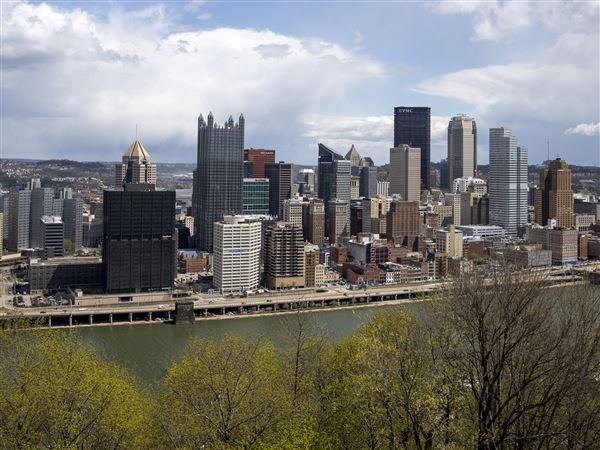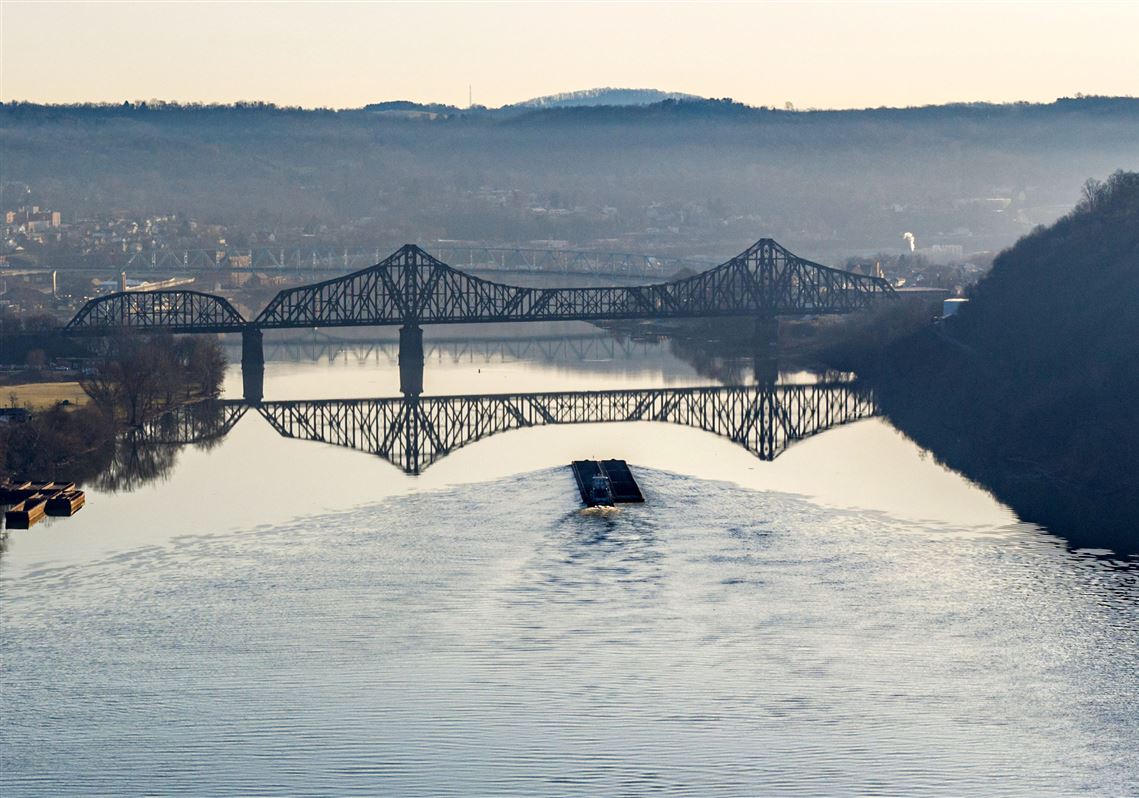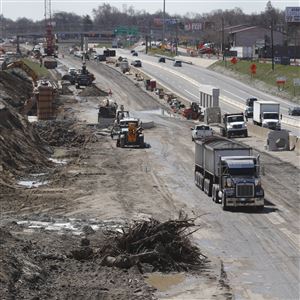Millions of gallons of briny, toxic, wastewater from shale gas drilling and fracking operations could soon be loaded onto barges and pushed down the Allegheny, Monongahela and Ohio rivers.
A loose network of river tank terminal and barge companies has floated plans to begin shipping wastewater containing petroleum condensates, cancer-causing chemicals and radioactive material, between as many as seven river terminal sites spread out over hundreds of miles of the region’s major waterways.
The barging of wastewater on rivers has been discussed for at least a dozen years, but like a tow on a sandbar, the industry initiative has been repeatedly sidelined due to permitting issues, environmental concerns and the risk of contamination of public water supplies that draw from the rivers.
Although shale gas well drilling and fracking have been in a trough due to low natural gas prices, interest in barging wastewater has rekindled in recent years as transport and disposal of the mixed liquid wastes have become costlier for the drilling industry.
In meetings, letters and emails with regulators, barge companies and terminal owners have pressed regulatory agencies to issue authorizations, approvals and permits. And drilling industry publications are touting the public safety and economic benefits of moving wastewater by tanker barge.
Last month, in the first publicized acknowledgement that the idea of wastewater barging is starting to move again, Belle Vernon-based Guttman Realty Co. received a grant of almost $500,000 from the Pennsylvania Department of Community and Economic Development’s Commonwealth Financing Authority to retrofit the existing tank and barge loading terminal along the Monongahela River in Speers, Washington County, 43.5 river miles above Pittsburgh’s Point.
The changes would allow the Speers terminal to accept tanker truckloads of wastewater, also known by the shale gas industry term “produced water,” according to an April news release touting the grant from State Rep. Bud Cook, R-Belle Vernon.
“The facility will be modified,” the release stated, “to accept waste water from the natural gas industry by truck to be stored in existing tanks and ultimately transported by barge to the treatment facility in Ohio.”
Using barges to transport wastewater also will reduce truck traffic, diesel exhaust, truck-auto collisions and road damage, the release stated.
But multiple environmental organizations from the tri-state area have strong concerns and many questions about those plans, saying river wastewater transport is poorly regulated and increases risks of chemical and radioactive spills, and those spills can contaminate waterways that are drinking water sources for millions of people, and, increasingly, recreational venues.
They say drilling and fracking wastewater contains salty brines, drilling and fracking chemicals and naturally occurring radioactive material flushed from shale formations thousands of feet underground. Radium-226 and radium-228, both found in brine waste, are known carcinogens and can cause bone, liver and breast cancer in high concentrations, according to the U.S. Centers for Disease Control and Prevention. The wastewater can also contain other radioactive components, including Potassium 40, Thorium 232, and Uranium 238.
“Our Three Rivers are going to become the grand speedway of fracking waste,” said Gillian Graber, executive director of Protect PT, a local Pennsylvania environmental organization. “All three of our major waterways could be impacted by a spill or release of fluids. Spills are scary, but the build-up of small releases is also a major concern.”
Sarah Martik, campaign director at the Center for Coalfield Justice, said in an email statement that barges are unreliable and the fracking wastewater is “extremely hazardous.”
“It is irresponsible to turn the Mon Valley into a funnel for regional fracking waste, just as it’s irresponsible to barge the waste down the river,” Ms. Martik said. “How many tons of coal are sitting at the bottom of the river from barges that have sunk in the past?”
The Monongahela River alone serves as the main source of water supply for some 850,000 residents in the Pittsburgh metropolitan region. And most of the drinking water for the city of Pittsburgh comes from the Allegheny River.
Other sites
In addition to the terminal at Speers, four other barge loading sites were identified in documents provided by the U.S. Coast Guard in response to a Freedom of Information Act request by the Fresh Water Accountability Project, an Ohio environmental organization that focuses on water protection and shared them with the Pittsburgh Post-Gazette.
Those loading terminals include another on the Monongahela River at Star City, near Morgantown, W.Va., 98.7 miles upriver from Pittsburgh; and two on the Ohio River, at Bellaire and Hannibal, Ohio, 93.5 miles and 123.1 miles downriver from Pittsburgh.
A fifth wastewater loading facility option is identified as the Nicholas Enterprises Inc. terminal in Freeport, Armstrong County, 29.6 miles up the Allegheny River from Pittsburgh, and 20 miles from the Pittsburgh Water and Sewer Authority’s water intake pipes at Aspinwall.
According to a November 2019 U.S. Coast Guard cargo authorization form, the plan at the time was to barge wastewater to unloading terminals owned by Enlink Midstream at Bells Run near Portland, Ohio, and DeepRock Disposal Solutions, LLC, in Marietta, Ohio, located 160 and 173 river miles, respectively, from Pittsburgh.
Houston-headquartered DeepRock, a business partner with Comtech Industries, owner of the Bellaire terminal, operates 12 deep disposal wells at five sites near the unloading terminals in Ohio and can accept up to 50,000 barrels or 2.1 million gallons of wastewater a day.
A Dec. 22 article on Comtech’s webpage states that DeepRock had received more than 30 permits and authorizations, is in “conversation” with river terminals on all three rivers, and is expected to begin receiving wastewater and unloading barges at its Marietta terminal during the first quarter of this year.
A day later, a headline in Marcellus Drilling News, an industry website, stated, “Barging Fracked Wastewater on Ohio River Approved! Starts in 1Q21,” referring to the first quarter of 2021.
But barging wastewater has not started yet, and Dean Grose, chief executive officer at Comtech, did not respond to requests for information about how that timeline has changed, what has caused the delay, or Comtech’s or DeepRock’s current plans for wastewater barging.
Taylor Grenert, Comtech marketing coordinator, cited nonspecific permitting issues when asked about the delay, but added that terminal facilities are “ready to go.”
One possible snag may be due to the Pennsylvania Department of Environmental Protection, which has had sporadic interactions with Guttman Realty, part of the multibillion-dollar Guttman Group, dating back more than a decade about using its river terminals to ship wastewater.
Most recently, on a June 2020 conference call with regulators from the DEP’s Southwest Region office, Guttman representatives raised the possibility of using the Speers bulk liquid storage terminal to receive, store, process, and transfer natural gas produced water to barges for out-of-state disposal.
But Lauren Failey, a DEP spokeswoman, said in an email response to questions that the company hasn’t applied for a residual waste transfer facility permit, which would be required for such a facility. She also said the DEP doesn’t regulate what is transported on the rivers.
James Lee, a spokesman for the Ohio Environmental Protection Agency, said the state doesn’t require a permit to transfer residual waste like Pennsylvania.
“While the facility may have existing permits or need additional permits from DEP for various activities, the act of shipping wastewater by barge from unconventional gas development in and of itself is not something that requires a DEP permit,” Ms. Fraley said.
Another snag is that Guttman, which didn’t respond to many interview requests during the past two weeks, sold its terminals in Star City and Belle Vernon, both on the Monongahela, to Zenith Energy Terminals PA Holdings LLC in January.
A water obstruction and encroachment permit was transferred to Zenith in April 2021. New permits would be required if Zenith chooses to modify the terminal facilities, Ms. Fraley said, but DEP has not had discussions or received any application.
Jay Reynolds, Zenith’s chief commercial officer, said none of the company’s terminals handle drilling wastewater, there are no plans to do so and it’s “not a business we are pursuing.”
Casey Smith, a spokeswoman for the state Pennsylvania Department of Community and Economic Development, said the department was told by Guttman that it would take six to eight months to get the DEP residual waste transfer permit, and must have all permit approvals before funds are disbursed.
“Should the company fail to obtain a permit from the DEP, they would be unable to draw down any funds and the grant would be liquidated,” Ms. Smith said.
Sending waste to Ohio
Disposal of drilling and fracking wastewater from the Marcellus and Utica shale gas fields in Pennsylvania, Ohio and West Virginia is now done via tanker truck, railroad and pipeline, which transport wastewater to deep injection disposal wells or distillation facilities.
Ben Hunkler, an organizer with Concerned Ohio River Residents, said Ohio has become “the de facto dumping ground for fracking wastewater produced in the Ohio River Valley, thanks to the state’s loose injection regulation.”
Mr. Hunkler said Ohio Department of Natural Resources records show that nearly half of the 38 million barrels of toxic waste injected into Ohio’s 226 disposal wells in 2017 was exported from West Virginia and Pennsylvania.
“Barging wastewater along the Ohio River,” he said, “could subject even more Ohio communities to the noxious air emissions and groundwater contamination common near waste injection wells.”
According to the Coast Guard documents, the wastewater, including small amounts of oil and liquid gas condensate, would be transported on the rivers in double-hulled steel tank barges capable of carrying flammable, combustible and hazardous cargo, and owned by Louisiana-based Settoon Towing, which had and has U.S. Coast Guard approval to barge oil and gas industry wastewater through Gulf Coast inland waterways for the last 30 years.
Randy Martin-Nez, executive vice president of Settoon Towing, said the company has received authorization from the Coast Guard to expand its operation into the Appalachian Basin’s rivers, but that move has been delayed by the economic downturn in the drilling industry, opposition from “liberals and tree huggers,” and what he termed the Biden administration’s anti-fracking policies.
He said one tanker barge can hold 25,000 barrels, or 1 million gallons, of produced water — the equivalent of 80 tanker trucks.
“To be scared of produced water is crazy. It’s not dangerous stuff,” Mr. Martin-Nez said in a phone interview. “We have the boats and barges authorized to do this, and we’re waiting for DeepRock and Guttman to finish their terminal upgrades so they can receive tanker trucks.”
Although the Coast Guard has authorized Settoon to barge wastewater in the Appalachian Basin, it classifies drilling and fracking wastewater more restrictively than Mr. Martin-Nez.
In letters to Settoon dated Oct. 31, 2018, and Nov. 12, 2019, the Coast Guard noted that its assessment of the proposed produced water cargo’s chemical properties found it contained benzene, a known human carcinogen.
And a Coast Guard directive titled “Produced Water Classification” from July 2020 noted that a 2013 policy allowing the transport of shale gas extraction waste by barge, requested by the industry, was withdrawn that same year “primarily due to significant environmental concerns with transporting a potentially radioactive product.” The document also states that because the chemical composition and radioactivity levels of the wastewater from different wells varies considerably, regular testing will be required.
Coast Guard Lt. Cmdr. Daniel Velez said if wastewater is barged on the rivers, it will be carried by a “red-flagged barge” because its cargo is considered “a hazardous material while in the barges and being transported.” Because the wastewater is a mixture of materials it is also classified as a “noxious liquid,” he stated.
Yuri Gorby, of the FreshWater Accountability Project, said allowing the barging of wastewater would be a failure of regulatory oversight.
“This waste is currently only regulated as a hazardous material when it’s on the barge,” Mr. Gorby said. “When it comes into Ohio and West Virginia to be processed or sent to disposal wells, it is not classified as a hazardous waste. People in our region will pay the price in the form of unnecessary exposures to radioactive materials.”
Drinking water concerns
The Charleroi Municipal Authority’s water intake is just a half-mile down the Monongahela River from the Speers Terminal. And at least a half-dozen public and private water intakes are also down river, including three operated by the Pennsylvania American Water Co., which provides approximately 583,000 people in Allegheny, Washington and Fayette counties with drinking water sourced from the Mon River.
“Barge traffic presents a potential risk to drinking water sources due to the potential for spills,” Pennsylvania American stated in a release by spokeswoman Heather DuBose. “This is why Pennsylvania American Water has invested in technology that continuously monitors our sources of supply and provides early detection of contamination events.”
The region’s biggest water company also said it depends on the Pennsylvania Department of Environmental Protection and the Coast Guard “to take environmental and drinking water protections into consideration in their permitting processes.”
Over on the Allegheny River, Dean Marlin, director of business development for Butler-based Nicholas Enterprises Inc., which owns the 17-tank bulk terminal at Freeport, said the company was active in pursuing the wastewater barging in the past and would like to be again.
“We were interested and we would be interested, but it was always blocked for one reason or another and we’ve not actively participated recently,” Mr. Marlin said. “If it did happen it would be great, but it would require a lot of investment and permitting work.”
The Nicholas terminal is located immediately upriver from the river water intake pipes of the Municipal Authority of Buffalo Township, which serves 8,000 people in Butler and Armstrong counties, including Freeport.
Freeport Mayor James Swartz said using the Nicholas terminal to load barges with wastewater increases risk to the public water supply.
“It’s definitely a concern with the ... plant as close as it is,” Mr. Swartz said. “A spill would create a catastrophe for customers.”
Leatra Harper, who filed the FOIA request for the Fresh Water Accountability Project, said barging a “witches’ brew of wastewater” ignores very real public health and safety risks.
“It opens a Pandora’s box of waste material on waterways that are our public drinking water sources,” Ms. Harper said. “And its sole purpose is to keep the drilling and fracking companies afloat.”
Don Hopey: dhopey@post-gazette.com
First Published: May 31, 2021, 9:30 a.m.























